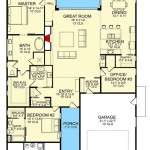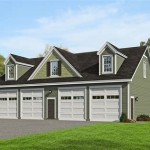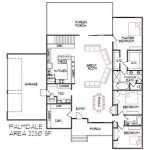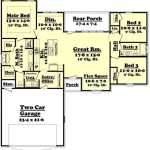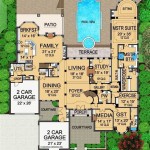One-Level House Plans with Basements
One-level living offers convenience and accessibility, eliminating the need to navigate stairs. Incorporating a basement into a single-story design adds valuable square footage without expanding the home's footprint. This combination creates a versatile living space that can adapt to changing needs and preferences. This article explores the advantages and considerations involved in choosing one-level house plans with basements.
Enhanced Accessibility
Single-story homes are inherently more accessible than multi-level designs. Eliminating stairs makes it easier for people with mobility challenges, seniors, and young children to navigate the entire house. A basement adds to this advantage by providing extra living space without requiring additional vertical movement within the main living area.
Increased Living Space
A basement significantly expands the usable square footage of a one-level home. This additional space offers flexibility for various purposes, including extra bedrooms, bathrooms, recreational areas, home offices, workshops, or storage. This can be particularly beneficial for growing families or those who frequently entertain guests. The basement can also be finished gradually, allowing homeowners to customize the space as their needs and budget allow.
Cost-Effectiveness
Building a basement can often be more cost-effective than adding a second story. Basements utilize the existing foundation of the home and minimize the need for extensive framing and roofing. While finishing a basement adds to the initial cost, it provides a significant return on investment by increasing the overall value of the property.
Design Flexibility
One-level house plans with basements offer a wide range of design possibilities. The main level can be designed for open-plan living, maximizing natural light and creating a sense of spaciousness. The basement can then be configured to accommodate specific needs, whether it be a dedicated home theater, a private guest suite, or a children's play area. The separation between the two levels allows for distinct functional zones within the home.
Energy Efficiency
Basements naturally contribute to energy efficiency. The earth surrounding the basement walls provides insulation, reducing heating and cooling costs. Proper insulation and sealing can further enhance energy performance, minimizing drafts and temperature fluctuations. This can lead to significant long-term savings on utility bills.
Natural Disaster Protection
In areas prone to severe weather events such as tornadoes or hurricanes, basements offer a valuable safe haven. Their location underground provides a degree of protection from strong winds and flying debris. Incorporating a designated storm shelter within the basement design further enhances safety during such emergencies.
Considerations for Basement Construction
While basements offer numerous benefits, certain considerations are crucial during the planning and construction phases. Proper waterproofing is essential to prevent moisture issues and potential damage. Adequate ventilation is necessary to control humidity and ensure air quality. Careful planning of egress windows and doors is critical for safety and code compliance. Consulting with experienced professionals specializing in basement construction is crucial for addressing these aspects effectively.
Light and Ventilation in Basements
One common concern with basements is the potential lack of natural light and ventilation. Careful planning and design can mitigate these issues. Larger windows, strategically placed to maximize sunlight penetration, can brighten the space. Walk-out basements, where part of the basement is above ground level, offer excellent access to natural light and outdoor spaces. Mechanical ventilation systems, including exhaust fans and air exchangers, can ensure proper airflow and prevent moisture buildup.
Basement Ceiling Height
Ceiling height is an important factor to consider in basement design. Higher ceilings create a more spacious and comfortable environment. Local building codes often dictate minimum ceiling heights for finished basements. If maximizing headroom is a priority, it's essential to factor this into the initial design plans and ensure adequate excavation depth during construction.
Future Adaptability
One of the key advantages of a basement is its adaptability. The space can be finished and utilized in various ways over time. Initially, it might serve as a playroom or storage area, later transforming into a home office, guest suite, or even a rental unit. This flexibility makes one-level house plans with basements a smart long-term investment, accommodating changing lifestyle needs over the years.

Single Floor House Plans With Basement Elegant E Story 28 Images 1 St One

Simple House Floor Plans 3 Bedroom 1 Story With Basement Home Design 1661 Sf Basementdesignflo One New

3500 Sf 4 Bedroom Single Story Home Plan 3 Bath Basement Garage Car Chicago Peoria Springfi Level House Plans

Small Cottage Plan With Walkout Basement Floor

Ranch House Plans Traditional Floor

Walkout Basement House Plans With Photos From Don Gardner Houseplans Blog Com

Low Cost Single Story 4 Bedroom House Floor Plans Country Farm 2200 Sf Basement One

House Designs Single Floor Low Cost Plans 3 Bedroom With Basement Ranch

Versatile Spacious House Plans With Basements Houseplans Blog Com

House Plans With Finished Basement Home Floor

